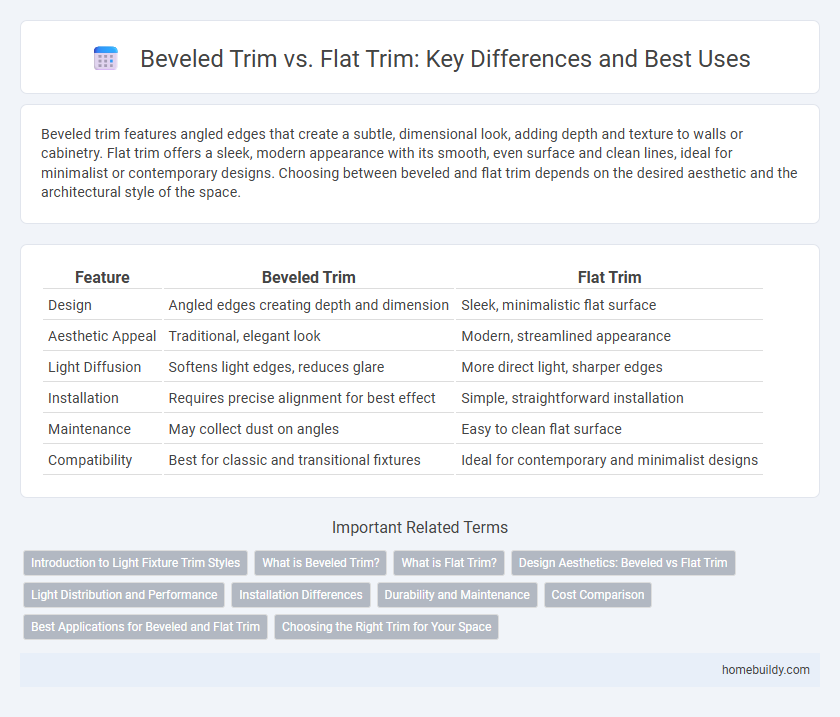Beveled trim features angled edges that create a subtle, dimensional look, adding depth and texture to walls or cabinetry. Flat trim offers a sleek, modern appearance with its smooth, even surface and clean lines, ideal for minimalist or contemporary designs. Choosing between beveled and flat trim depends on the desired aesthetic and the architectural style of the space.
Table of Comparison
| Feature | Beveled Trim | Flat Trim |
|---|---|---|
| Design | Angled edges creating depth and dimension | Sleek, minimalistic flat surface |
| Aesthetic Appeal | Traditional, elegant look | Modern, streamlined appearance |
| Light Diffusion | Softens light edges, reduces glare | More direct light, sharper edges |
| Installation | Requires precise alignment for best effect | Simple, straightforward installation |
| Maintenance | May collect dust on angles | Easy to clean flat surface |
| Compatibility | Best for classic and transitional fixtures | Ideal for contemporary and minimalist designs |
Introduction to Light Fixture Trim Styles
Beveled trim on light fixtures features angled edges that create depth and a more decorative appearance, enhancing the overall design by adding dimension and softness to the lighting fixture. Flat trim, in contrast, offers a sleek, minimalistic look with sharp, clean lines that blend seamlessly into ceilings or walls, making it ideal for modern and understated decor. Choosing between beveled and flat trim styles depends on the desired aesthetic effect and how the light fixture integrates with the surrounding architectural elements.
What is Beveled Trim?
Beveled trim in light fixtures features angled edges that create a chamfered border, enhancing depth and adding a decorative dimension to the fixture. This type of trim contrasts with flat trim, which has a simple, flush edge and offers a minimalist aesthetic. Beveled trim improves light diffusion and shadow casting, contributing to a more refined and visually appealing lighting design.
What is Flat Trim?
Flat trim in light fixtures is a type of decorative edging that lies flush with the ceiling surface, creating a sleek and minimalist appearance. Unlike beveled trim, which features angled edges that add depth and dimension, flat trim provides a clean, streamlined look ideal for modern or contemporary interiors. Its simple design makes it easier to install and maintain while enhancing the fixture's subtle integration into the ceiling plane.
Design Aesthetics: Beveled vs Flat Trim
Beveled light fixture trim offers a dimensional design aesthetic that enhances depth and shadow play, creating a sophisticated, layered look ideal for contemporary or transitional interiors. Flat trim provides a sleek, minimalist appearance that blends seamlessly with ceilings, emphasizing clean lines and modern simplicity suited for understated or modern designs. Choosing beveled trim emphasizes texture and contrast, while flat trim prioritizes subtlety and uniformity in lighting design.
Light Distribution and Performance
Beveled trim enhances light distribution by directing illumination outward, reducing glare and creating a softer, more diffused ambiance compared to flat trim. Flat trim offers a minimalist aesthetic but can cause more direct, concentrated light that may result in harsher shadows and uneven lighting. The choice between beveled and flat trim significantly impacts the performance and visual comfort of recessed lighting installations.
Installation Differences
Beveled trim requires precise alignment due to its angled edges, which can complicate installation compared to flat trim's straightforward, flush mounting. Flat trim offers easier attachment with minimal adjustments, making it suitable for quick installations and ensuring a seamless fit against ceilings or walls. Proper measurement and cutting are critical for beveled trim to maintain aesthetic consistency and prevent gaps during installation.
Durability and Maintenance
Beveled trim in light fixtures offers enhanced durability due to its angled edges, which resist chipping and wear better than flat trim surfaces. Maintenance is simplified with beveled trim as its sloped design helps prevent dust accumulation and makes cleaning easier compared to flat trims that trap debris more readily. Flat trims may require more frequent upkeep to maintain their appearance, while beveled trims provide long-lasting resilience and lower maintenance efforts.
Cost Comparison
Beveled trim for light fixtures generally costs more than flat trim due to its intricate design and additional manufacturing processes. Flat trim offers a more budget-friendly option while maintaining a sleek and modern look. The price difference can vary by material and brand, but beveled trim typically adds 10-30% more to the overall fixture cost.
Best Applications for Beveled and Flat Trim
Beveled trim is ideal for traditional or decorative settings where the angled edges add depth and visual interest to recessed lighting fixtures. Flat trim works best in modern, minimalist designs, providing a sleek, flush finish that blends seamlessly with ceilings. Choosing beveled trim enhances architectural detail, while flat trim prioritizes clean lines and unobtrusive lighting.
Choosing the Right Trim for Your Space
Beveled trim offers a three-dimensional edge that enhances architectural depth and adds a subtle shadow effect, making it ideal for spaces seeking visual interest and sophistication. Flat trim provides a clean, minimalist look that seamlessly blends into the ceiling, perfect for modern and understated interiors. Selecting between beveled and flat trim depends on the room's design style, lighting needs, and the desired aesthetic impact.
beveled trim vs flat trim Infographic

 homebuildy.com
homebuildy.com